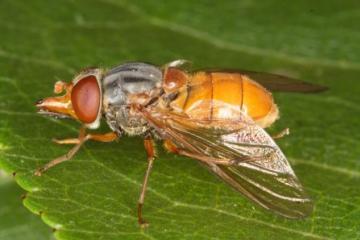Species Account for Rhingia rostrata
Rhingia rostrata (Linnaeus, 1758)
Diptera: Syrphidae: Syrphidae

Reproduction for study and non-profit use permitted, all other rights reserved.
Taxonomic group: hoverflies (Diptera: Syrphidae) - Available county data
View time series maps for Rhingia rostrata
member log-on for taxon report
Images
upload a new image
Essex Red Data List comment
Recorded from 5 out of 57x10km.sq. records in county
Species text
Listed as Vulnerable (RDB2) in the Red Data Book (Shirt, 1987) the status of Rhingia rostrata was revised to Nationally Scarce (Notable) in the review by Falk (1991). Records are widely dispersed in southern England extending as far north as Worcestershire and also in Wales, with about 25 widely scattered post 1960 sites known. The occurrence of the fly is said to be infrequent and very erratic, but has been found regularly in the Kentish Weald (E. Philp, pers. comm.). The occurrence in numbers in the field layer of a woodland block at Basildon Golf Course is the first Essex record (R. Payne, pers. comm.). There is an association with ancient broadleaved woodlands, and although nothing is known about its larval habitat requirements, badger latrines have been suggested as a possibility (Stubbs & Falk, 2002). Shaded conditions could be required and adults feed on a range of tubular flowers. References
Habitats
Recorded management for locations with Rhingia rostrata
Recorded substrate and hydrology for locations with Rhingia rostrata
Why not join the Club, register and add a new species page
Interpretation of distribution maps




















